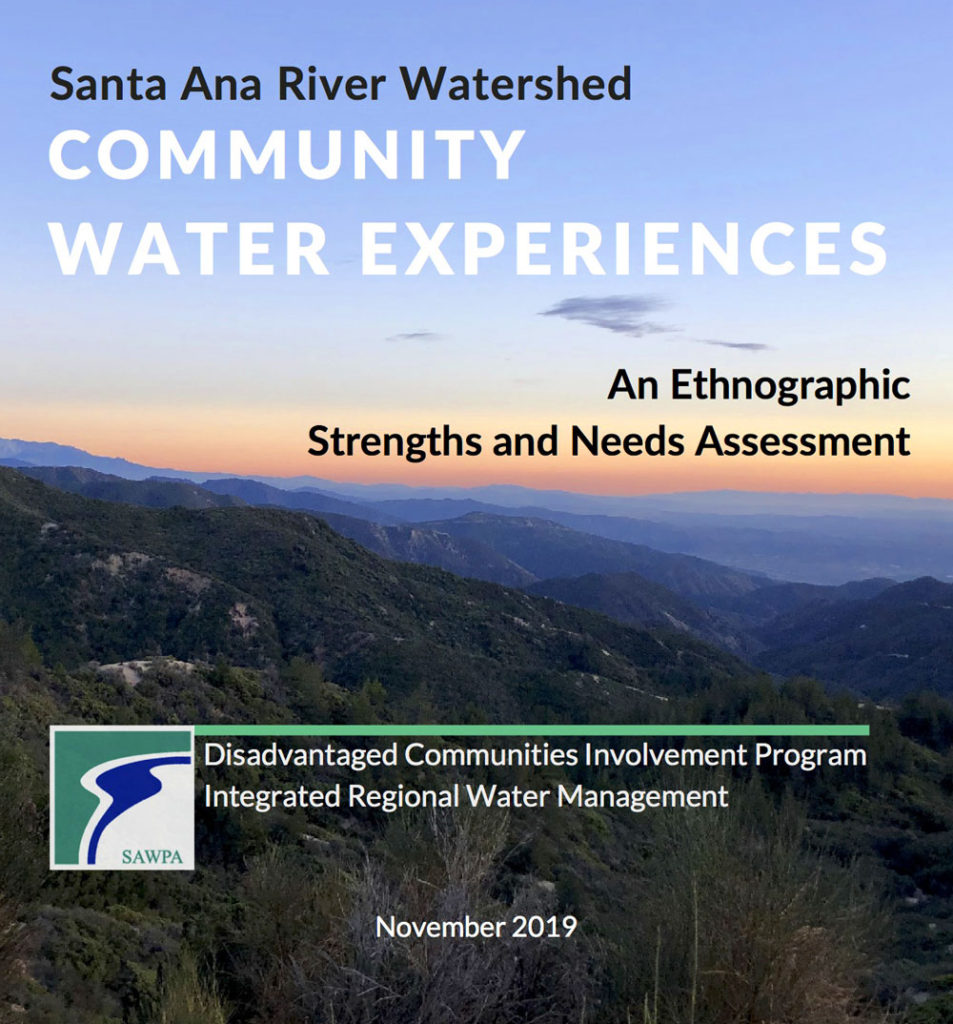Santa Ana River Watershed Community Water Experiences: An Ethnographic Strengths and Needs Assessment

SAWPA partnered with the University of California, Irvine’s Department of Anthropology and California State University Water Resources and Policy Initiatives to design and implement an ethnographic approach to learning and documenting the social experiences of water in the various communities across the Watershed.
The Community Water Ethnography of the Santa Ana Watershed records the findings of the Strengths and Needs Assessment conducted in the Santa Ana Watershed by the partners engaged in the DCI program. An initial version of this report was finalized and published by SAWPA in November 2019. At that time, the expectation was that CSUSB Native Listening Team would work with Sacred Places Institute of Indigenous Studies to conduct Orange County Tribal Sessions, to be incorporated at a later date. SAWPA will release the revised version with CSUSB Native Listening Team’s final edits as soon as possible.
What is Civic Ethnography?
Program partners conducted interviews and listening sessions using carefully crafted, open-ended questions and prompts posed to all community stakeholder groups. Each prompt or question was designed to elicit descriptive perspectives on personal experiences related to broad topics such as “community strengths” and “water stories.”
Posing the same open-ended questions allowed everyone to speak in the way that was most meaningful for them and to discuss their lived experiences to a greater degree than would have been possible using surveys or limited engagement sessions. Most importantly, the listening sessions and interviews created an opportunity for respondents to talk about processes, strengths, and needs not already anticipated by SAWPA or other water agencies in the watershed.
What is Civic Ethnography?
- Community Listening Sessions: CSU Fullerton and the UCI Newkirk Center
- Water Agency Interviews: SAWPA and CivicSpark
- Mutual Water Company Interviews: California Rural Water Association
- Elected Leader Interviews: Local Government Commission
- Tribal Community Listening Sessions: CSU San Bernardino
Why this Approach?
The DCI Program hopes to better connect water agencies with communities to resolve issues related to water management. Historically, planning and implementation processes carried out by water agencies have not always enabled the ability of the public to voice input regarding what they see as their own community’s strengths and needs. Some agencies’ public comment periods may be too short or poorly publicized, and the power dynamics between elected officials and community members may prevent productive collaboration.
Using civic ethnography in engagement processes prioritizes first-hand interactions with people in their own cultural environment.
Ethnography, at its core, recognizes that community members possess unique knowledges about their environments. In other words, ethnography accepts community members as experts of their strengths and needs. Tools typically used by civic ethnographers, such as open-ended questions within cultural contexts of governance and planning, can aid in identifying community needs and strengths, and can better inform the development of policies and programs for distributing financial resources to alleviate and empower those identified needs and strengths. Furthermore, ethnographic strategies can help inform decision making processes by creating a platform upon which community members can interact with decision makers and other stakeholders to develop strategies that meet both local and regional needs. The value of ethnography is not just associated with its ability to understand people within the context of their own environments, but also its potential to help reframe the policymakers’ and government’s relationship with the communities they serve.
Ethnographic Strengths and Needs Assessment Report
Report by Chapters
- COVER PAGE
- TABLE OF CONTENTS

